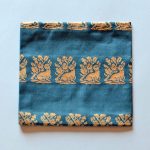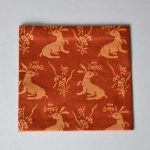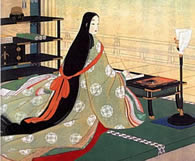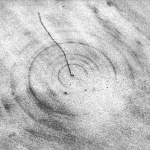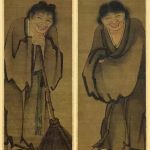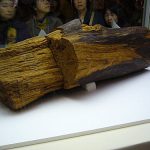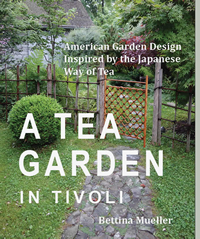Crimson colors
Sei Shonagon sometimes gets irritated with those who wear unsuitable things like “crimson skirted trousers” at the wrong time. And then at times she loves “a white coat worn over a violet waistcoat.”
Fabric has always been important in Japan. Today in Kyoto you can visit the shop of Kitamura Tokusai who will bring out sample after sample of old and ancient fabrics that are now used in the tea ceremony to hold a tea bowl in hand. They are called Kobukusa and are much admired. Dazzling and splendid.
Not being comfortable
Tea practice, a Zen art, has always been a challenge. From the first time I learned how to fold a silk square of fabric into an elegant wiping cloth there has always been something new to wake me up – challenge me in unexpected ways.
The art of the gathering is the appreciation and deep respect for the objects whether they be new or old or ancient or with provenance.
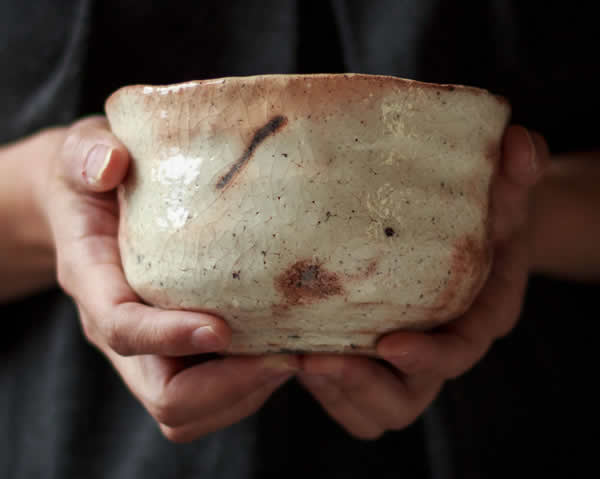
My new tea bowl by Kouichi Osada
Today was a first for me. I was totally unsettled by a guest who is a ‘professional’ potter. With my new precious tea bowl in her hands she put the first and second digits of her fingers into a slingshot and slung her nail hard into the side of the bowl. WHACK.
“Oh, don’t do that!” I said. What was she thinking? Was she testing the validity of the glaze or the way in which it was fired? I don’t know. The bowl could have been shattered.
I’m trusting that my tea bowl will be ok.
But imagine if the bowl had survived hundreds of years and you had the honor to hold it in your hands marveling at the beauty of it and the many generations that had taken care of this fragile pottery and then someone comes along and WHACKS it. Just so they could.
I still can’t get over this. Maybe in time…
So cold it’s cold
Third Sunday morning Zen in the Tea House
It was 17 degrees this morning and all week we’ve been in deep January cold. The tea house is warmed by a single electric heater, but today it was challenged to keep the room cozy and warm. I thought I’d talk about a koan from the Blue Cliff Record, Tozan’s “No Cold or Heat.”
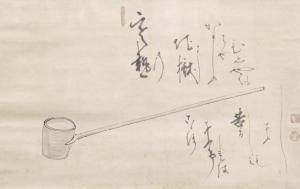
Here’s a black and white Zen painting of a bamboo ladle with the words “When it’s hot, be hot”. This refers to Tozan’s reply to the monk who asked “Cold and heat descend upon us. How can we avoid them?”
Tozan said, “Why don’t you go where there is no cold or heat?”
The monk then said “Where is that place?”
Tozan replied, “When cold, let it be so cold that it kills you; when hot, let it be so hot that it kills you.”
Remember that Tozan was living in Sung dynasty China in the 9th century. What was his life like then? Surely there were no electric heaters to warm even the smallest space. I imagine Tozan as small and robust. Someone you wouldn’t want to tangle with. But meet him then, or meet him now, his response still cuts to the quick.
But I might phrase his answer in a softer tone…
We talked about this koan and how it relates to Zen practice. Many new students since Tozan’s time have been given the instruction, “Count your exhalation from one to ten, and then start over. “
This sounds very simplistic yet it’s quite hard to do. And it’s not counting like you ordinarily do in school or when you’re adding up things on your fingers. It’s diving into that count and exhalation with all your might. That’s what Tozan is saying. Live every moment so completely that you are nothing but it. Nothing but hot, or cold, or THIS very moment.
This morning it was wonderful to be together in the warm tea house on such a cold day, sitting silently, afterwards sharing a cup of tea and talking together about our practice.
Then Emily Dickenson showed up. Not literally of course, since she died quite a long while ago, but her words came alive as this poem was recited.
I’m Nobody! Who are you?
Are you – Nobody – too?
Then there’s a pair of us!
Dont tell! they’d advertise – you know!
How dreary – to be – Somebody!
How public – like a Frog –
To tell one’s name – the livelong June –
To an admiring Bog!
Someone said, “Emily was hot. She lived her life hot.”
Thank you Emily. Thank you Tozan.















